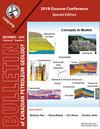阿萨巴斯卡油砂中角砾管和天坑连接的流化床和泥石流:蒸发岩岩溶塌陷引起的断块碰撞动力学
Q3 Earth and Planetary Sciences
引用次数: 15
摘要
阿萨巴斯卡油砂沉积北段中泥盆统下第三系蒸发岩溶蚀作用、岩溶塌陷作用导致上泥盆统地层破碎成不同沉降断块镶嵌。区域性盐溶塌陷在次白垩纪不整合上发育了长达50 km的构造槽。上面形成的构造洼地塌陷共线排列,充满盐水,在草原蒸发岩盐层内延伸高达100米的蒸发岩溶解烟囱。沿断层线溶解趋势发育了单独的和联合的溶解烟囱阵列,这些溶解烟囱将10公里宽的草原蒸发岩盐崖切割开。萨斯喀彻温省中部中泥盆世蒸发岩盆地沉积中心烟囱崩塌构造的三维地震图像是用来解释上泥盆世演替和上覆下白垩统麦克默里组中明显的崩塌构造的类似物。位于溶蚀烟囱上方的泥盆系-白垩系断裂束缚地块为重力驱动的塌陷构造。这些结构包括倾斜旋转轨迹在下降和进入下伏溶蚀空洞。角砾岩管道沿着断块间断裂面的较深处受到冲击,相邻的块体相互倾斜旋转,在垂直下降过程中形成挤压和伸展床层变形带。角砾岩管道沿断裂面向上进入斜剪切带,层状扭曲,相邻块体间呈锯齿状缝合焊接。碰撞带上游相邻块体之间以挤压变形为主,形成了被断裂面一侧束缚的陷落孔发育。持续的地层压缩使许多天坑构造变形和破碎。其中一些坍塌引起的断块碰撞表明发生了灾难性事件,并引起地震活动,引发角砾岩管道上部的流化,并以泥石流的形式在相邻断块表面上扩散。本文章由计算机程序翻译,如有差异,请以英文原文为准。
Breccia pipe and sinkhole linked fluidized beds and debris flows in the Athabasca Oil Sands: dynamics of evaporite karst collapse-induced fault block collisions
Abstract The Middle Devonian hypogene evaporite dissolution, karst collapse resulted in the fragmentation of the Upper Devonian strata into a mosaic of differentially subsided fault blocks underlying the northern area of the Athabasca Oil Sands Deposit. Regional salt dissolution collapse developed structural troughs up to 50 km long on the sub-Cretaceous unconformity. The structural depressions formed above collapsed collinearly aligned, brine-filled, evaporite dissolution chimneys extending up to 100 m high within the Prairie Evaporite salt beds. Individual and coalesced arrays of dissolution chimneys developed along fault lineament dissolution trends that dissected the 10 km wide Prairie Evaporite salt scarp. 3D seismic images of chimney collapse structures in the Middle Devonian evaporite basin depocenter across central Saskatchewan are analogues used to interpret collapse structures evident in the Upper Devonian succession and the overlying Lower Cretaceous McMurray Formation. The Devonian-Cretaceous fault bound blocks located above the dissolution chimneys were gravity driven collapse structures. These structures included oblique rotational trajectories during the descents towards and into underlying dissolution voids. Breccia pipes were impinged along the deeper reaches of the inter-block fault planes as adjacent blocks obliquely rotated apart and towards each other, resulting in zones with compressional and extensional bed deformations during the variable but often rapid rates of vertical descent. The breccia pipes pass upward, along fault planes, into oblique shear zones with twisted beds and zigzag suture welding between adjacent blocks. Upper reaches of the collision zone, between adjacent blocks, were dominated by compressional deformations that resulted in sinkhole development bound on one side by the fault plane. Continued bed compression deformed and fragmented many sinkhole structures. Some of these collapse-induced fault block collisions suggest cataclysmic events, and caused seismicity triggered fluidization in the upper intervals of breccia pipes with mobilization as debris flows that spread across adjacent fault block surfaces.
求助全文
通过发布文献求助,成功后即可免费获取论文全文。
去求助
来源期刊

Bullentin of Canadian Petroleum Geology
Earth and Planetary Sciences-Geochemistry and Petrology
CiteScore
2.50
自引率
0.00%
发文量
0
期刊介绍:
The Bulletin of Canadian Petroleum Geology is a peer-reviewed scientific journal published four times a year. Founded in 1953, the BCPG aims to be the journal of record for papers dealing with all aspects of petroleum geology, broadly conceived, with a particularly (though not exclusively) Canadian focus. International submissions are encouraged, especially where a connection can be made to Canadian examples.
 求助内容:
求助内容: 应助结果提醒方式:
应助结果提醒方式:


